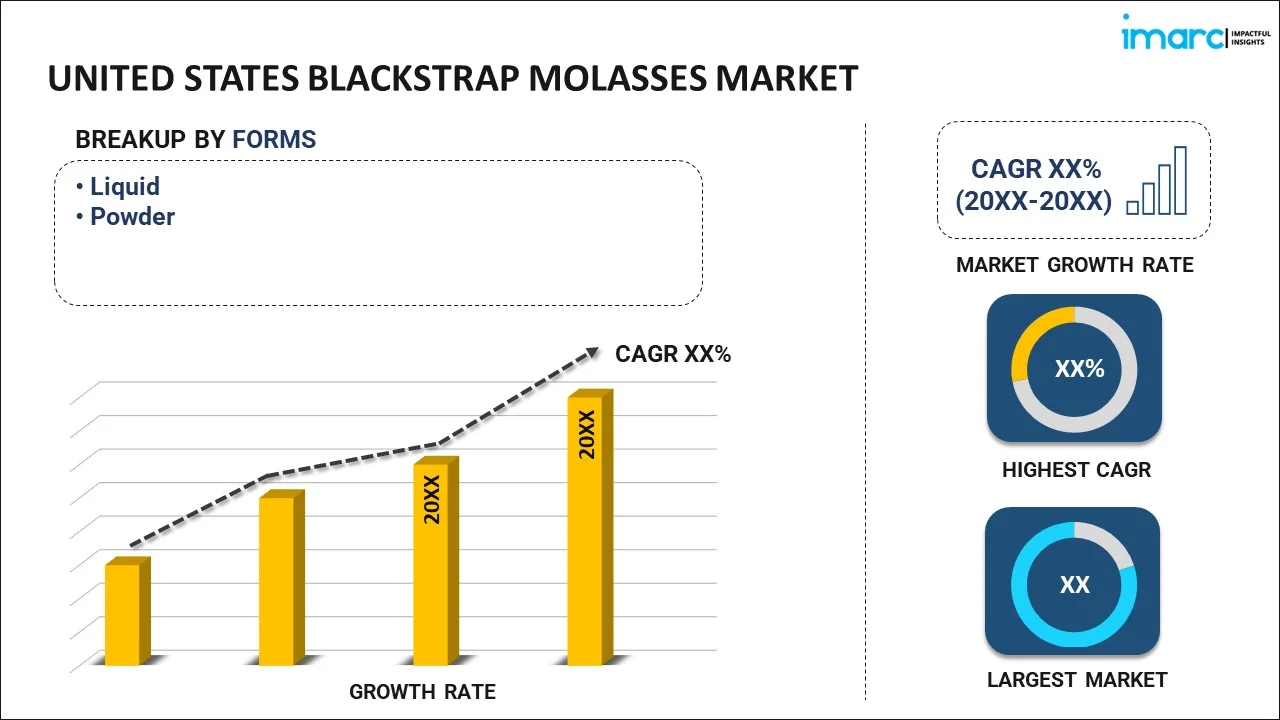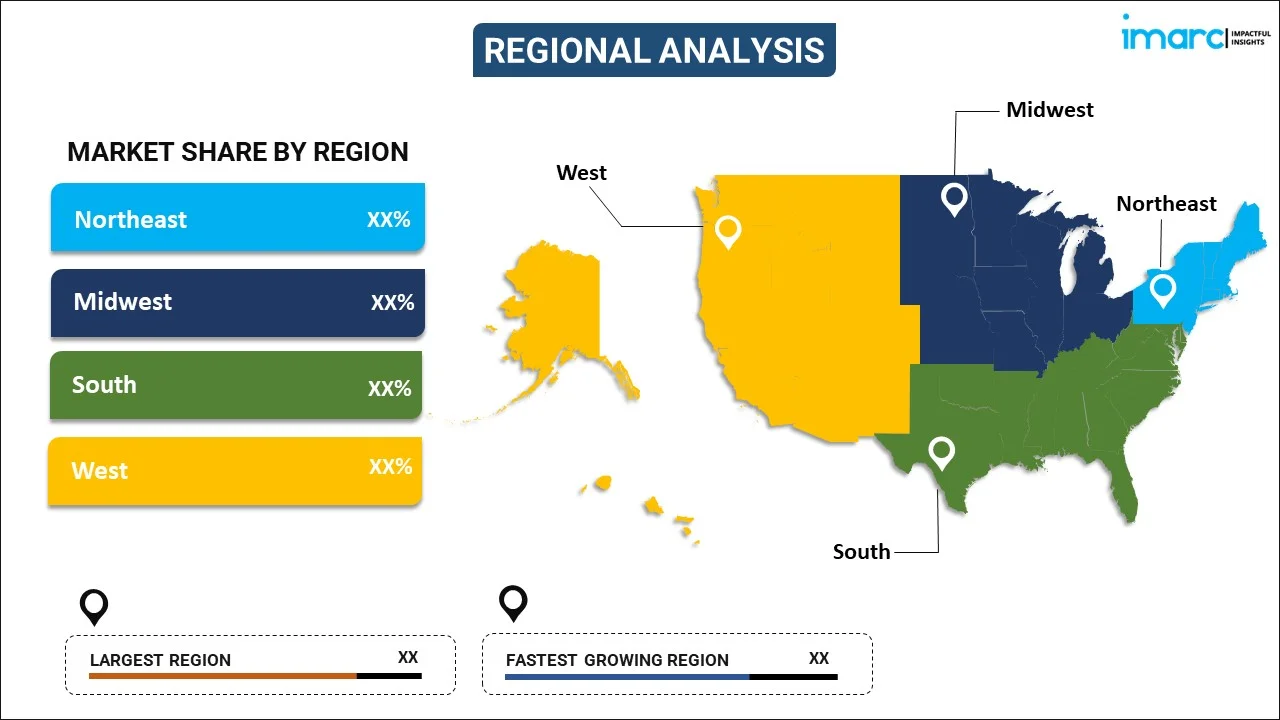
United States Blackstrap Molasses Market Report by Form (Liquid, Powder), Product (Organic, Conventional), Distribution Channel (Offline, Online), Application (Industrial Fermentation, Food and Beverages, Pharmaceutical, Animal Feed, and Others), and Region 2025-2033
Market Overview:
United States blackstrap molasses market size reached USD 3.4 Billion in 2024. Looking forward, IMARC Group expects the market to reach USD 5.6 Billion by 2033, exhibiting a growth rate (CAGR) of 5.13% during 2025-2033. The changing consumer preferences and the growing demand for functional and wholesome ingredients are primarily driving the United States blackstrap molasses market share across the country.
|
Report Attribute
|
Key Statistics
|
|---|---|
|
Base Year
|
2024 |
|
Forecast Years
|
2025-2033
|
|
Historical Years
|
2019-2024
|
| Market Size in 2024 | USD 3.4 Billion |
| Market Forecast in 2033 | USD 5.6 Billion |
| Market Growth Rate (2025-2033) | 5.13% |
United States Blackstrap Molasses Market Analysis:
- Major Drivers: Increased demand for natural sweeteners, increasing health awareness, and fast-growing interest in plant-based diets are major drivers. Blackstrap molasses' high content of iron, calcium, and potassium makes it attractive to health-conscious consumers. Demand is further boosted by use in the baking industry, animal feed, and fermentation, helping drive consistent United States blackstrap molasses market growth across various industries
- Major Market Trends: Shoppers are moving toward clean-label goods, increasing demand for blackstrap molasses as a minimally processed sweetener. Organic and non-GMO options enhance its market position. Furthermore, craft beverages made from molasses, natural health remedies, and sustainable industrial applications emphasize innovation, influencing a trend toward sustainable and functional uses.
- Market Opportunities: Growing applications in health supplements, nutraceuticals, and plant-based food formulations create excellent growth opportunities. Export potential, fueled by U.S. molasses quality standards, boosts market opportunities. Firms can leverage growing consumer demand for natural ingredients and functional foods, as value-added product development, including fortified molasses blends, further diversifies top-line earnings.
- Market Challenges: According to the United States blackstrap molasses market analysis, unstable sugarcane yield, reliance on international supply chains, and competition from other natural sweeteners such as honey or agave pose challenges. Volatility in prices and limited consumer knowledge regarding the special advantages of blackstrap molasses might limit adoption. Moreover, strict labeling laws and sugar consumption concerns could limit wider mainstream market entry.
Blackstrap molasses serves as a sweetener derived from the processing of various sources such as raw sugar beets, sugarcane, pomegranate, dates, carob, and sorghum. In comparison to regular molasses, it is characterized by its lower calorie content and enriched composition of essential elements like calcium, potassium, selenium, magnesium, and niacin. This natural sweetener contributes to preventing blood clotting, alleviating menstrual cramps, promoting uterine muscle health, and easing symptoms of premenstrual syndrome (PMS). Additionally, it plays a role in stress and anxiety management, mood control, and the prevention of pain, depression, and fatigue. In the present scenario, blackstrap molasses finds application in the food and beverage (F&B) industry, where it adds moisture and tenderness to baked goods while extending their shelf life.
United States Blackstrap Molasses Market Trends:
Rising Demand for Natural and Functional Sweeteners
One of the strongest drivers in the U.S. blackstrap molasses market is the increasing consumer trend toward natural, minimally processed sweeteners. In contrast to refined sugar, blackstrap molasses contains beneficial nutrients like iron, calcium, magnesium, and potassium that contribute to its health benefits and popularity with consumers seeking healthy options. As awareness grows regarding the negative effects on health of artificial sweeteners and high-fructose corn syrup, consumers are turning to alternatives that meld taste with functional value. Blackstrap molasses is most appealing to those who want to increase iron consumption or enhance bone structure. Its role as a sweetener with nutritional value has increased its use in baking, culinary use, and beverage development. It benefits from the increasingly popular clean-label trend, which values transparency and natural origin. Because consumers continue looking for sweeteners that provide health advantages in addition to taste, blackstrap molasses is picking up new momentum in mainstream food markets.
Expanding Applications in Food, Beverage, and Animal Feed
The other key driver is the multi-industry versatility of blackstrap molasses. In the food and beverage industry, it is used extensively in baking, sauces, confectionery, and as a flavor enhancer in beverages, ranging from craft beers to rum. Its strong flavor and natural sweetness make it worth its weight in product development. Apart from human use, blackstrap molasses has a significant function in the animal feed sector, where it serves as a source of energy, binder, and palatability promoter for animal feed. The fermentation sector also uses molasses as an affordable raw material for producing ethanol. The broad range of uses guarantees stable demand, offsetting seasonal patterns in particular sectors. With food producers and animal producers focusing on cost-effective, multipurpose ingredients, the versatility of blackstrap molasses in various end-use markets continues to support its market development.
Growth of Plant-Based and Organic Food Movements
The growing demand for vegan, vegetarian, and flexitarian diets in the U.S. has established a good climate for blackstrap molasses. All these consumers are looking for dense nutrition that aligns with their ethical and health concerns. Blackstrap molasses, a plant-based ingredient with high mineral content, is perfectly positioned within this trend. The increasing demand for non-GMO and organic-certified products also benefits the market, as manufacturers increase lines that adhere to such criteria. Furthermore, wellness-driven trends like holistic nutrition and functional foods highlight ingredients that provide flavor and health as well, where blackstrap molasses is an excellent fit. Its function as a natural iron supplement, especially among vegan consumers, contributes to its popularity. With the U.S. food system moving toward sustainable, ethical, and nutrient-dense products, blackstrap molasses has much to gain in the growing plant-based and organic markets.
United States Blackstrap Molasses Market Segmentation:
IMARC Group provides an analysis of the key trends in each segment of the market, along with forecasts at the country level for 2025-2033. Our report has categorized the market based on form, product, distribution channel, and application.
Form Insights:

To get more information on this market, Request Sample
- Liquid
- Powder
The report has provided a detailed breakup and analysis of the market based on the form. This includes liquid and powder.
Product Insights:
- Organic
- Conventional
A detailed breakup and analysis of the market based on product have also been provided in the report. This includes organic and conventional.
Distribution Channel Insights:
- Offline
- Online
The report has provided a detailed breakup and analysis of the market based on the distribution channel. This includes offline and online.
Application Insights:
- Industrial Fermentation
- Food and Beverages
- Pharmaceutical
- Animal Feed
- Others
A detailed breakup and analysis of the market based on application have also been provided in the report. This includes industrial fermentation, food and beverages, pharmaceutical, animal feed, and others.
Regional Insights:

- Northeast
- Midwest
- South
- West
The report has also provided a comprehensive analysis of all the major regional markets, which include the Northeast, Midwest, South, and West.
Competitive Landscape:
The market research report has also provided a comprehensive analysis of the competitive landscape in the market. Competitive analysis such as market structure, key player positioning, top winning strategies, competitive dashboard, and company evaluation quadrant has been covered in the report. Also, detailed profiles of all major companies have been provided.
United States Blackstrap Molasses Market Report Coverage:
| Report Features | Details |
|---|---|
| Base Year of the Analysis | 2024 |
| Historical Period | 2019-2024 |
| Forecast Period | 2025-2033 |
| Units | Billion USD |
| Scope of the Report | Exploration of Historical Trends and Market Outlook, Industry Catalysts and Challenges, Segment-Wise Historical and Future Market Assessment:
|
| Forms Covered | Liquid, Powder |
| Products Covered | Organic, Conventional |
| Distribution Channels Covered | Offline, Online |
| Applications Covered | Industrial Fermentation, Food and Beverages, Pharmaceutical, Animal Feed, Others |
| Regions Covered | Northeast, Midwest, South, West |
| Customization Scope | 10% Free Customization |
| Post-Sale Analyst Support | 10-12 Weeks |
| Delivery Format | PDF and Excel through Email (We can also provide the editable version of the report in PPT/Word format on special request) |
Key Benefits for Stakeholders:
- IMARC’s industry report offers a comprehensive quantitative analysis of various market segments, historical and current market trends, market forecasts, and dynamics of the United States blackstrap molasses market from 2019-2033.
- The research report provides the latest information on the market drivers, challenges, and opportunities in the United States blackstrap molasses market.
- Porter's five forces analysis assist stakeholders in assessing the impact of new entrants, competitive rivalry, supplier power, buyer power, and the threat of substitution. It helps stakeholders to analyze the level of competition within the United States blackstrap molasses industry and its attractiveness.
- A competitive landscape allows stakeholders to understand their competitive environment and provides an insight into the current positions of key players in the market.
Key Questions Answered in This Report
The blackstrap molasses market in United States was valued at USD 3.4 Billion in 2024.
The United States blackstrap molasses market is projected to exhibit a CAGR of 5.13% during 2025-2033, reaching a value of USD 5.6 Billion by 2033.
The U.S. blackstrap molasses market is driven by rising demand for natural sweeteners, growth in health-conscious consumer trends, and applications in food, beverages, and animal feed. Its nutritional benefits, including iron and minerals, along with expanding use in baking, confectionery, and biofuel production, further boost market growth.
Need more help?
- Speak to our experienced analysts for insights on the current market scenarios.
- Include additional segments and countries to customize the report as per your requirement.
- Gain an unparalleled competitive advantage in your domain by understanding how to utilize the report and positively impacting your operations and revenue.
- For further assistance, please connect with our analysts.
 Request Customization
Request Customization
 Speak to an Analyst
Speak to an Analyst
 Request Brochure
Request Brochure
 Inquire Before Buying
Inquire Before Buying




.webp)




.webp)












